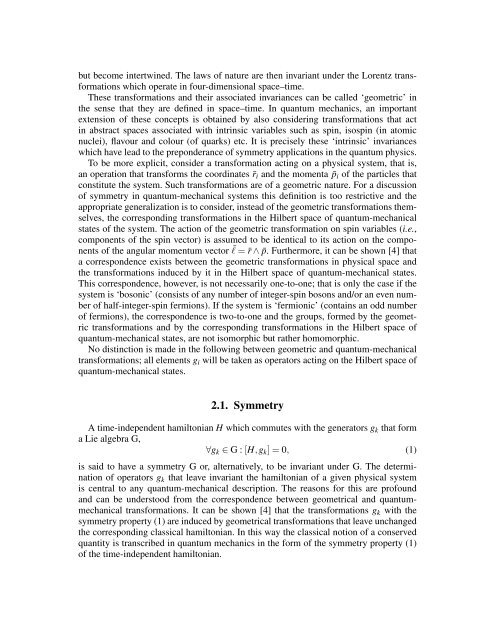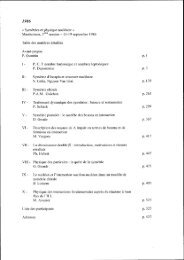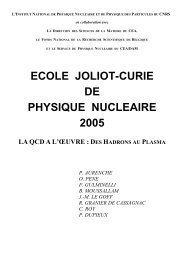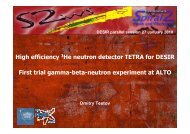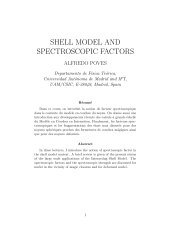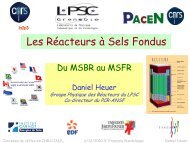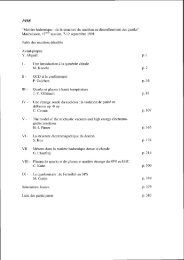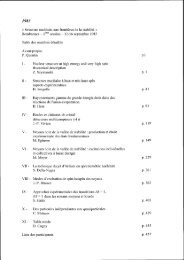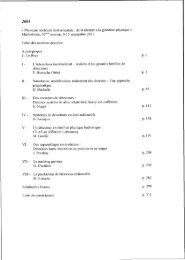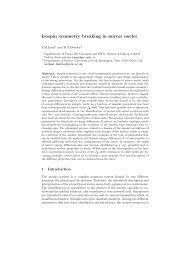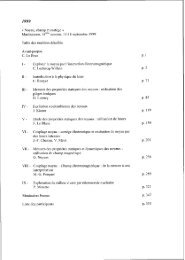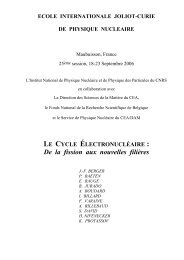SYMMETRIES IN NUCLEI - Cenbg - IN2P3
SYMMETRIES IN NUCLEI - Cenbg - IN2P3
SYMMETRIES IN NUCLEI - Cenbg - IN2P3
Create successful ePaper yourself
Turn your PDF publications into a flip-book with our unique Google optimized e-Paper software.
ut become intertwined. The laws of nature are then invariant under the Lorentz transformationswhich operate in four-dimensional space–time.These transformations and their associated invariances can be called ‘geometric’ inthe sense that they are defined in space–time. In quantum mechanics, an importantextension of these concepts is obtained by also considering transformations that actin abstract spaces associated with intrinsic variables such as spin, isospin (in atomicnuclei), flavour and colour (of quarks) etc. It is precisely these ‘intrinsic’ invarianceswhich have lead to the preponderance of symmetry applications in the quantum physics.To be more explicit, consider a transformation acting on a physical system, that is,an operation that transforms the coordinates ¯r i and the momenta ¯p i of the particles thatconstitute the system. Such transformations are of a geometric nature. For a discussionof symmetry in quantum-mechanical systems this definition is too restrictive and theappropriate generalization is to consider, instead of the geometric transformations themselves,the corresponding transformations in the Hilbert space of quantum-mechanicalstates of the system. The action of the geometric transformation on spin variables (i.e.,components of the spin vector) is assumed to be identical to its action on the componentsof the angular momentum vector ¯l = ¯r ∧ ¯p. Furthermore, it can be shown [4] thata correspondence exists between the geometric transformations in physical space andthe transformations induced by it in the Hilbert space of quantum-mechanical states.This correspondence, however, is not necessarily one-to-one; that is only the case if thesystem is ‘bosonic’ (consists of any number of integer-spin bosons and/or an even numberof half-integer-spin fermions). If the system is ‘fermionic’ (contains an odd numberof fermions), the correspondence is two-to-one and the groups, formed by the geometrictransformations and by the corresponding transformations in the Hilbert space ofquantum-mechanical states, are not isomorphic but rather homomorphic.No distinction is made in the following between geometric and quantum-mechanicaltransformations; all elements g i will be taken as operators acting on the Hilbert space ofquantum-mechanical states.2.1. SymmetryA time-independent hamiltonian H which commutes with the generators g k that forma Lie algebra G,∀g k ∈ G : [H,g k ] = 0, (1)is said to have a symmetry G or, alternatively, to be invariant under G. The determinationof operators g k that leave invariant the hamiltonian of a given physical systemis central to any quantum-mechanical description. The reasons for this are profoundand can be understood from the correspondence between geometrical and quantummechanicaltransformations. It can be shown [4] that the transformations g k with thesymmetry property (1) are induced by geometrical transformations that leave unchangedthe corresponding classical hamiltonian. In this way the classical notion of a conservedquantity is transcribed in quantum mechanics in the form of the symmetry property (1)of the time-independent hamiltonian.


